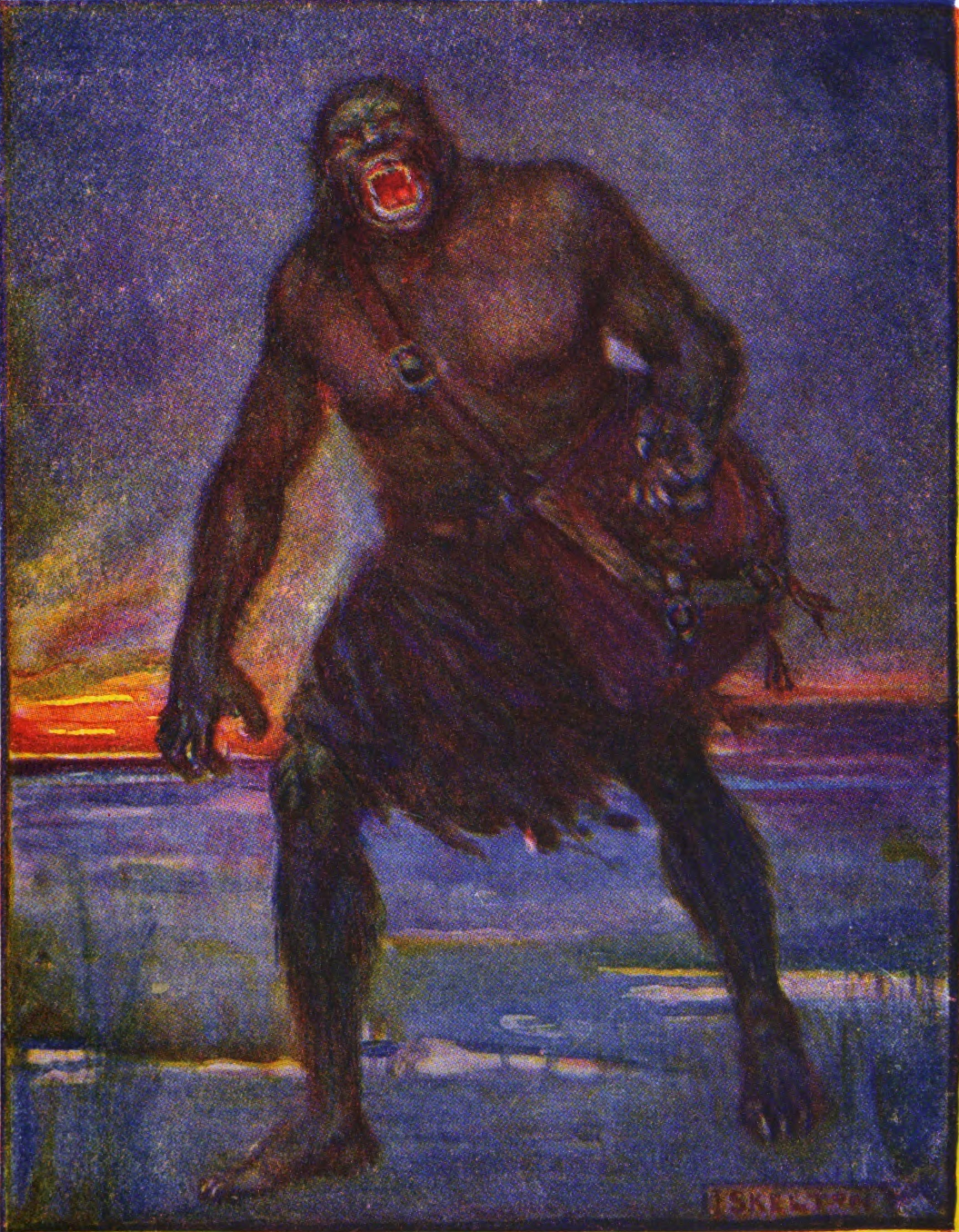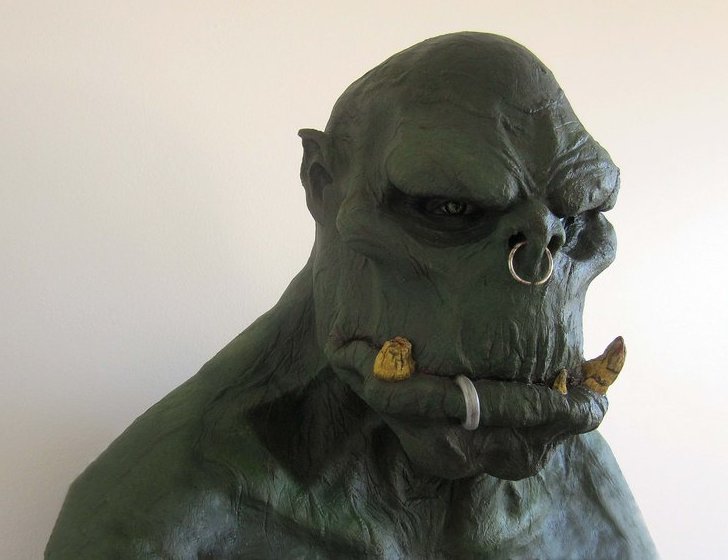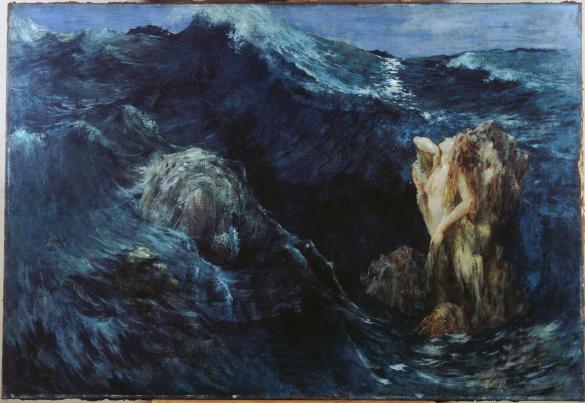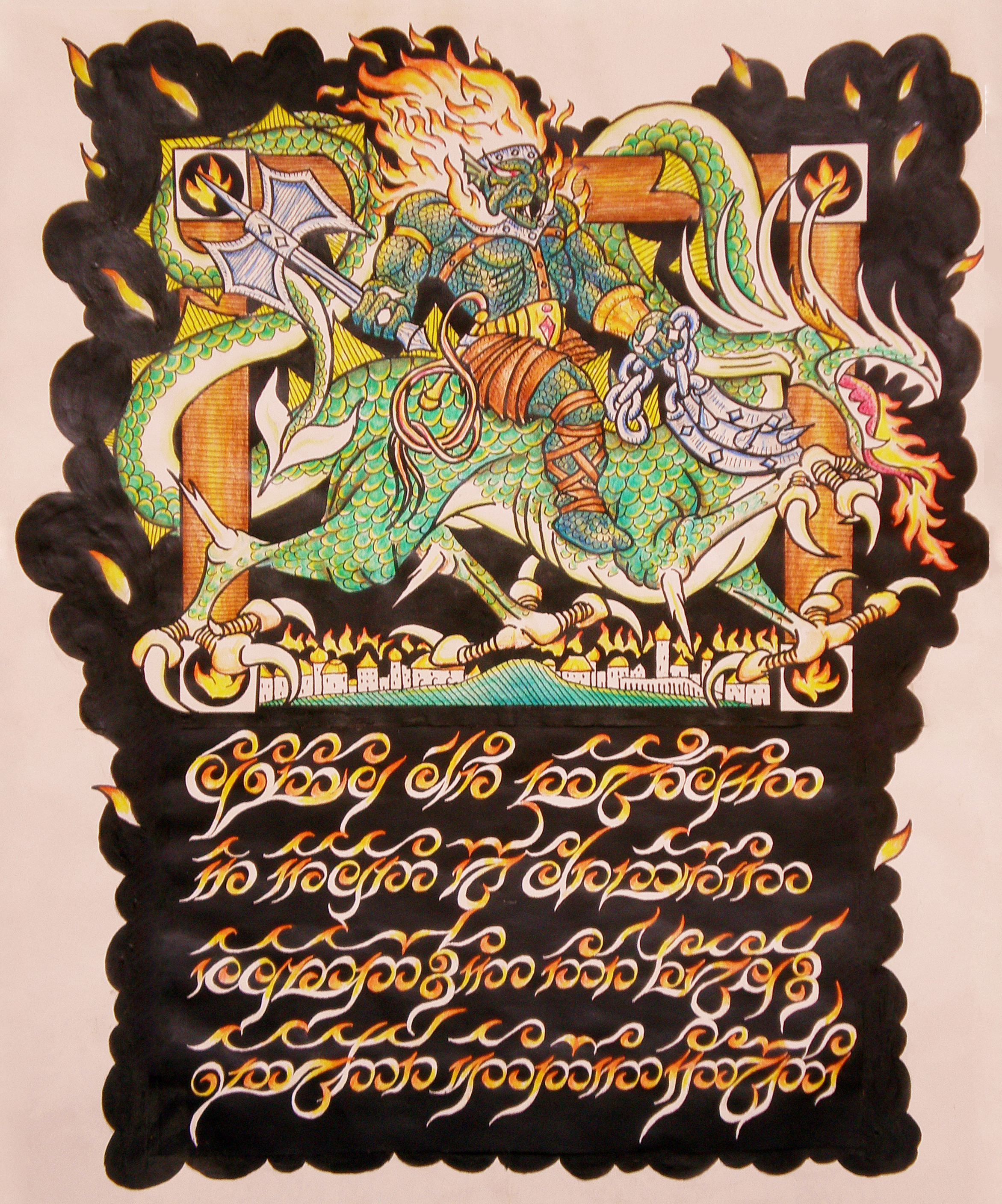|
Tolkien's Monsters
Tolkien's monsters are the evil beings, such as Orcs, Trolls, and giant spiders, who oppose and sometimes fight the protagonists in J. R. R. Tolkien's Middle-earth legendarium. Tolkien was an expert on Old English, especially ''Beowulf'', and several of his monsters share aspects of the ''Beowulf'' monsters; his Trolls have been likened to Grendel, the Orcs' name harks back to the poem's ''orcneas'', and the dragon Smaug has multiple attributes of the ''Beowulf'' dragon. The European medieval tradition of monsters makes them either humanoid but distorted, or like wild beasts, but very large and malevolent; Tolkien follows both traditions, with monsters like Orcs of the first kind and Wargs of the second. Some scholars add Tolkien's immensely powerful Dark Lords Morgoth and Sauron to the list, as monstrous enemies in spirit as well as in body. Scholars have noted that the monsters' evil nature reflects Tolkien's Roman Catholicism, a religion which has a clear conception of good ... [...More Info...] [...Related Items...] OR: [Wikipedia] [Google] [Baidu] |
Orcs
An Orc (or Ork) is a fictional humanoid monster like a goblin. Orcs were brought into modern usage by the fantasy writings of J. R. R. Tolkien, especially ''The Lord of the Rings''. In Tolkien's works, Orcs are a brutish, aggressive, ugly, and malevolent race of monsters, contrasting with the benevolent Elves. There is a suggestion, among several somewhat contradictory origin stories, that they are a corrupted race of elves. Mythological monsters with names similar to "orc" can be found in the Old English poem ''Beowulf'', in Early Modern poetry, and in Northern European folk tales and fairy tales. Tolkien stated that he took the name from ''Beowulf''. The orc appears on lists of imaginary creatures in two of Charles Kingsley's mid-1860s novels. Tolkien's concept of orcs has been adapted into the fantasy fiction of other authors, and into games of many different genres such as ''Dungeons & Dragons'', ''Magic: The Gathering'', and ''Warcraft''. Etymology Old English ... [...More Info...] [...Related Items...] OR: [Wikipedia] [Google] [Baidu] |
The Hobbit
''The Hobbit, or There and Back Again'' is a children's fantasy novel by English author J. R. R. Tolkien. It was published in 1937 to wide critical acclaim, being nominated for the Carnegie Medal and awarded a prize from the '' New York Herald Tribune'' for best juvenile fiction. The book remains popular and is recognized as a classic in children's literature. ''The Hobbit'' is set within Tolkien's fictional universe and follows the quest of home-loving Bilbo Baggins, the titular hobbit, to win a share of the treasure guarded by a dragon named Smaug. Bilbo's journey takes him from his light-hearted, rural surroundings into more sinister territory. The story is told in the form of an episodic quest, and most chapters introduce a specific creature or type of creature of Tolkien's geography. Bilbo gains a new level of maturity, competence, and wisdom by accepting the disreputable, romantic, fey, and adventurous sides of his nature and applying his wits and common s ... [...More Info...] [...Related Items...] OR: [Wikipedia] [Google] [Baidu] |
Gandalf
Gandalf is a protagonist in J. R. R. Tolkien's novels ''The Hobbit'' and ''The Lord of the Rings''. He is a Wizards (Middle-earth), wizard, one of the ''Istari'' order, and the leader of the Fellowship of the Ring (characters), Fellowship of the Ring. Tolkien took the name "Gandalf" from the Old Norse Dvergatal, "Catalogue of Dwarves" (''Dvergatal'') in the ''Völuspá''. As a wizard and the bearer of one of the Three Rings, Gandalf has great power, but works mostly by encouraging and persuading. He sets out as Gandalf the Grey, possessing great knowledge and travelling continually. Gandalf is focused on the mission to counter the Dark Lord Sauron by destroying the One Ring. He is associated with fire; his ring of power is Narya, the Ring of Fire. As such, he delights in fireworks to entertain the hobbits of the Shire, while in great need he uses fire as a weapon. As one of the Maiar, he is an immortal spirit from Valinor, but his physical body can be killed. In ''The Hobbit' ... [...More Info...] [...Related Items...] OR: [Wikipedia] [Google] [Baidu] |
Cockney
Cockney is an accent and dialect of English, mainly spoken in London and its environs, particularly by working-class and lower middle-class Londoners. The term "Cockney" has traditionally been used to describe a person from the East End, or born within earshot of Bow Bells, although it most commonly refers to the broad variety of English native to London. Estuary English is an intermediate accent between Cockney and Received Pronunciation, also widely spoken in and around London, as well as in wider southeastern England. In multicultural areas of London, the Cockney dialect is, to an extent, being replaced by Multicultural London English—a new form of speech with significant Cockney influence. Words and phrases Etymology of Cockney The earliest recorded use of the term is 1362 in passus VI of William Langland's ''Piers Plowman'', where it is used to mean "a small, misshapen egg", from Middle English ''coken'' + ''ey'' ("a cock's egg"). Concurrently, the mythical land of l ... [...More Info...] [...Related Items...] OR: [Wikipedia] [Google] [Baidu] |
The Silmarillion
''The Silmarillion'' () is a collection of myths and stories in varying styles by the English writer J. R. R. Tolkien. It was edited and published posthumously by his son Christopher Tolkien in 1977, assisted by the fantasy author Guy Gavriel Kay. It tells of Eä, a fictional universe that includes the Blessed Realm of Valinor, the once-great region of Beleriand, the sunken island of Númenor, and the continent of Middle-earth, where Tolkien's most popular works—''The Hobbit'' and ''The Lord of the Rings''—are set. After the success of ''The Hobbit'', Tolkien's publisher Stanley Unwin requested a sequel, and Tolkien offered a draft of the writings that would later become ''The Silmarillion''. Unwin rejected this proposal, calling the draft obscure and "too Celtic", so Tolkien began working on a new story that eventually became ''The Lord of the Rings''. ''The Silmarillion'' has five parts. The first, ''Ainulindalë'', tells in mythic style of the creation of Eä, the "worl ... [...More Info...] [...Related Items...] OR: [Wikipedia] [Google] [Baidu] |
Pterodactyl
Pterosaurs (; from Greek ''pteron'' and ''sauros'', meaning "wing lizard") is an extinct clade of flying reptiles in the order, Pterosauria. They existed during most of the Mesozoic: from the Late Triassic to the end of the Cretaceous (228 to 66 million years ago). Pterosaurs are the earliest vertebrates known to have evolved powered flight. Their wings were formed by a membrane of skin, muscle, and other tissues stretching from the ankles to a dramatically lengthened fourth finger. There were two major types of pterosaurs. Basal pterosaurs (also called 'non-pterodactyloid pterosaurs' or 'rhamphorhynchoids') were smaller animals with fully toothed jaws and, typically, long tails. Their wide wing membranes probably included and connected the hind legs. On the ground, they would have had an awkward sprawling posture, but the anatomy of their joints and strong claws would have made them effective climbers, and some may have even lived in trees. Basal pterosaurs were insectiv ... [...More Info...] [...Related Items...] OR: [Wikipedia] [Google] [Baidu] |
Nazgûl
The Nazgûl (from Black Speech , "ring", and , "wraith, spirit"), introduced as Black Riders and also called Ringwraiths, Dark Riders, the Nine Riders, or simply the Nine, are fictional characters in J. R. R. Tolkien's Middle-earth. They were nine Men who had succumbed to Sauron's power through wearing Rings of Power, which gave them immortality but reduced them to invisible wraiths, servants bound to the power of the One Ring and completely under Sauron's control. ''The Lord of the Rings'' calls them Sauron's "most terrible servants". Their leader, known as the Lord of the Nazgûl or the Witch-king of Angmar, had once been the King of Angmar in the north of Eriador. At the end of the Third Age, their main stronghold was the city of Minas Morgul at the entrance to Sauron's realm, Mordor. They dress entirely in black. In their early forays, they ride on black horses; later they ride flying monsters, which Tolkien described as " pterodactylic". Their main weapon is terror, thou ... [...More Info...] [...Related Items...] OR: [Wikipedia] [Google] [Baidu] |
Watcher In The Water
The Watcher in the Water is a fictional creature in J. R. R. Tolkien's Middle-earth; it appears in ''The Fellowship of the Ring'', the first volume of ''The Lord of the Rings''.''The Fellowship of the Ring'', book 2, ch. 4 "A Journey in the Dark" Lurking in a lake beneath the western walls of the Dwarf (Middle-earth), dwarf-realm Moria (Middle-earth), Moria, it is said to have appeared after the damming of the river Sirannon, and its presence was first recorded by Balin (Middle-earth), Balin's dwarf company 30 or so years before the beginning of ''The Fellowship of the Ring''. The origins of the creature are not described in Tolkien's works, but critics have compared it to the legendary kraken and to Odysseus's passage between the devouring Scylla and the whirlpool Charybdis. Its presence in combination with the barrier lake and the formidable Doors of Durin have been likened to the multiple obstacles often found in Norse mythology. Literature In ''The Lord of the Rings'', the F ... [...More Info...] [...Related Items...] OR: [Wikipedia] [Google] [Baidu] |
Shelob
Shelob is a fictional demon in the form of a giant spider from J. R. R. Tolkien's ''The Lord of the Rings''. Her lair lies in Cirith Ungol ("the pass of the spider") leading into Mordor. The creature Gollum deliberately leads the Hobbit protagonist Frodo Baggins, Frodo there in hopes of recovering the One Ring by letting Shelob attack Frodo. The plan is foiled when Samwise Gamgee temporarily blinds Shelob with the Phial of Galadriel, and then severely wounds her with Frodo's Elvish sword, Sting (Middle-earth), Sting. Some scholars have stated that Shelob is in the literary tradition of female monsters. Others have interpreted her as symbolising a sexual threat, with multiple sexual allusions. Scholars have noted her opposition to the Elves, and in particular her adversary, Galadriel, whose light helps the hobbits to defeat her darkness. Shelob's appearance in Peter Jackson's The Lord of the Rings film series, film trilogy was based on the Porrhothele antipodiana, New Zealand t ... [...More Info...] [...Related Items...] OR: [Wikipedia] [Google] [Baidu] |
Ungoliant
Ungoliant () is a fictional character in J. R. R. Tolkien's legendarium, described as an evil spirit in the form of a spider. Her name means "dark spider" in Sindarin. She is mentioned briefly in ''The Lord of the Rings'', and plays a supporting role in ''The Silmarillion'', enabling the Dark Lord Melkor to destroy the Two Trees of Valinor, darkening the world. Her origins are unclear, as Tolkien's writings do not explicitly reveal her nature, other than that she is from "before the world"; this may mean she is a Maia, an immortal spirit. Scholars have likened the story of Ungoliant and Melkor to John Milton's ''Paradise Lost'', where Sin conceives a child, Death, by Satan: Sin and Death are always hungry. There are limited parallels in Norse myth: while there are female giants, they are not usually spiders, though the Devil appears as a spider in an early Icelandic tale, and a female giant in the ''Prose Edda'' is named Nott ("Night"), she and her brood dwelling in and person ... [...More Info...] [...Related Items...] OR: [Wikipedia] [Google] [Baidu] |
Balrog
A Balrog () is a powerful demonic monster in J. R. R. Tolkien's Middle-earth. One first appeared in print in his high-fantasy novel ''The Lord of the Rings'', where the Fellowship of the Ring (characters), Fellowship of the Ring encounter a Balrog known as Durin's Bane in the Mines of Moria (Middle-earth), Moria. Balrogs appear also in Tolkien's ''The Silmarillion'' and other posthumously published books. Balrogs are tall and menacing beings who can shroud themselves in fire, darkness, and shadow. They are armed with fiery whips "of many thongs", and its early drafts speak frequently of the whips of fire. ''The Lays of Beleriand'' describe Morgoth's prisoners tortured by Balrogs with scourges; and the Balrog in Moria (''The Fellowship of the Ring'', "The Bridge of Khazad-dûm") is armed explicitly with a "whip of many thongs" or strands. and occasionally use long swords. In Tolkien's later conception, they could not be readily vanquished—a certain stature was required by the w ... [...More Info...] [...Related Items...] OR: [Wikipedia] [Google] [Baidu] |
Tolkien's Legendarium
Tolkien's legendarium is the body of J. R. R. Tolkien's mythopoeic writing, unpublished in his lifetime, that forms the background to his ''The Lord of the Rings'', and which his son Christopher summarized in his compilation of ''The Silmarillion'' and documented in his 12-volume series ''The History of Middle-earth''. The legendarium's origins reach back to 1914, when Tolkien began writing poems and story sketches, drawing maps, and inventing languages and names as a private project to create a unique English mythology. The earliest story drafts (of ''The Book of Lost Tales'') are from 1916; he revised and rewrote these for most of his adult life. ''The Hobbit'' (1937), Tolkien's first published novel, was not originally part of the larger mythology but became linked to it. Both ''The Hobbit'' and ''The Lord of the Rings'' (1954 and 1955) took place in the Third Age of Middle-earth, while virtually all of his earlier writing had been set in the first two ages of the world. ... [...More Info...] [...Related Items...] OR: [Wikipedia] [Google] [Baidu] |




.png)


